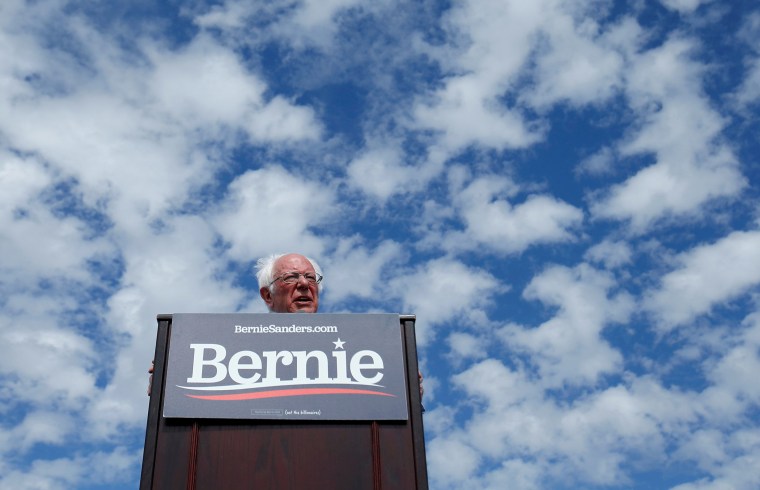There was good reason to think Bernie Sanders was on the verge of running away with the Democratic presidential nomination.
It was the night of Feb. 22, a Saturday, and he had just posted an overwhelming victory in the Nevada caucuses. He'd built that victory with strong support from younger voters, but also — and crucially, it seemed — with surprising strength among nonwhite Democrats. Exit polls showed Sanders rolling up 50 percent of the Hispanic vote and hitting 28 percent among African Americans, just 10 points behind Joe Biden.
This Nevada dominance came after Sanders had also posted a narrow win in New Hampshire and had emerged — after a comically delayed reporting process — as the popular vote victor in the Iowa caucuses (although he did finish microscopically behind Pete Buttigieg in the convoluted "state delegate equivalent" tally used to determine an official winner). So Sanders could — and did — claim to have posted victories in the first three states.
Moreover, the candidates who'd run closest to Sanders in Iowa and New Hampshire — Buttigieg, Elizabeth Warren and Amy Klobuchar — had all finished in the dust in Nevada. And the man who had been the national front-runner for just about the entire campaign, Joe Biden, appeared to be falling flat on his face — fourth place in Iowa, fifth in New Hampshire and a very distant second in Nevada (where he lost to Sanders two-to-one in the popular vote).
So the pieces seemed in place for Sanders.
He was winning states and building momentum. He was showing the potential to attract significant nonwhite support. He was broadly liked by Democratic voters. A February poll gave him a 71 percent favorable rating from Democratic voters — the highest of any candidate. Surely, it seemed, this was the moment when the bandwagon effect would take hold and Democratic voters would climb on board with the leader
The next state up was South Carolina, where Biden had long enjoyed comfortable leads. But with Sanders' early state success, and Biden's failures, the polls were already tightening. And now, with his Nevada landslide, it looked quite possible that Sanders would vault past Biden and win the Palmetto State outright — effectively ending the Democratic race on the spot.
Instead, though, it was this moment of seeming triumph that ushered in the swift and decisive demise of the Sanders campaign.
The reason now seems simple and obvious, even if it was far from apparent in the moment.
When he won Nevada, Sanders instantly moved into a position he had never before occupied: the clear front-runner for the Democratic presidential nomination. This changed the way the rest of the party thought about him and talked about him. His detractors sounded a loud and urgent alarm, declaring that his nomination would alienate swing voters and help President Donald Trump win reelection.
It was in this moment that South Carolina's most influential Democrats, Rep. James Clyburn, issued a deeply personal endorsement of Biden. In the closing days of the South Carolina campaign, Sanders found himself on the defensive, answering questions about his praise of some aspects of Fidel Castro's rule in Cuba.
Exactly one week after Nevada, Sanders was crushed in South Carolina's primary.
The margin shocked even those who'd expected Biden to win: 29 points. Sanders finished with just 20 percent, even less than the paltry 24 percent he'd nabbed four years earlier against Hillary Clinton. Most devastating for Sanders, his four-year quest to build inroads with black voters, who make up a majority of South Carolina's Democratic electorate, lay in ruins. He finished with a mere 17 percent of the black vote, barely ahead of Tom Steyer, and miles behind Biden.
All of a sudden, Biden had new life.
It was like Iowa and New Hampshire and Nevada had never happened for him. Endorsements came rolling in — including from Buttigieg and Klobuchar, who each dropped out within 48 hours of the South Carolina result. On Super Tuesday, Biden pulled off what had been unthinkable just days earlier: He earned more delegates than Sanders, winning states where he hadn't even campaigned.
It was clear then where this race was going.
There was a bandwagon effect taking place, and it was for Biden — not Sanders. Exit polls in state after state told the story. There were stark limits to Sanders' appeal. With black voters, he was stuck at his 2016 levels of support. That Nevada breakthrough had been a mirage. With voters over 45, a majority of the Democratic Party, he lost handily. Among those over 65, he was an asterisk. With the blue collar white voters who had kept him in contention against Clinton late into the '16 primaries, he was now losing decisively to Biden.
There was — and still is — a giant chunk of Democratic voters who have positive feelings toward Bernie Sanders. Some of them voted for him. But when they came face to face with the possibility that he'd be their nominee for president, the rest of them just wouldn't.

